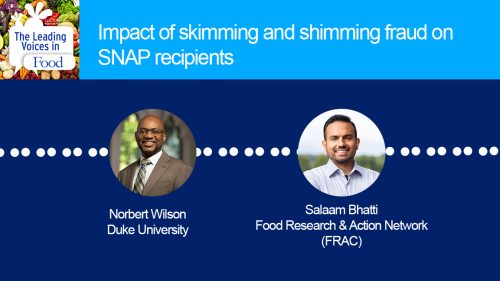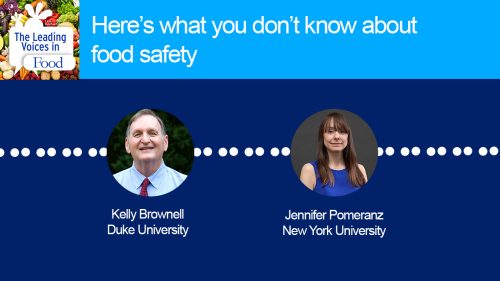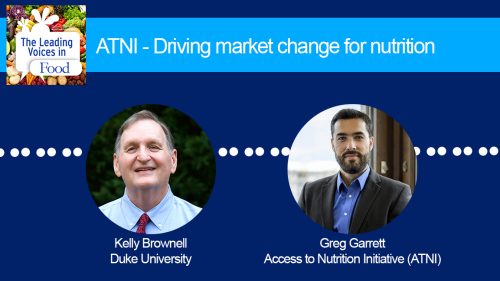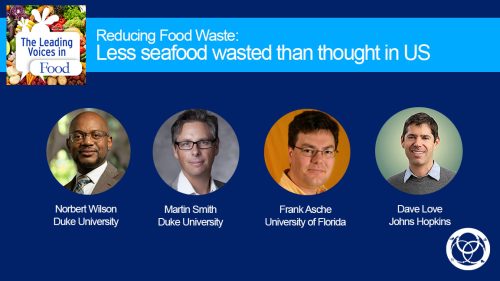The Leading Voices in Food
E53: Michael Osterholm on Food Safety and Killer Germs
With our daily food now coming from around the world, keeping food safe needs to be a practice of prevention–at home and in commercial factories. Food safety and infectious disease expert Michael Osterholm helps to explain.
Subscribe: Apple Podcasts | TuneIN | YouTube Music | SoundCloud | PocketCasts | Radio Public
Tags: Food Policy | Food Safety & Food Defense |

Michael Osterholm is the Regents Professor, McKnight Presidential Endowed Chair in Public Health, and the director of the Center for Infectious Disease Research and Policy at the University of Minnesota. He is a member of the National Academy of Medicine and the Council of Foreign Relations. In 2018 and 19, he served as science envoy for health security on behalf of the U.S. Department of State. He is the author of the 2017 book entitled Deadliest Enemy: Our War Against Killer Germs. He is widely regarded as a leading expert on infectious disease and recognized for his work far and wide.
Interview Summary
Salmonella outbreak from eggs sickens 38 people in seven states. Ground beef producer issues recall due to deadly E. coli outbreak. Americans told to stop eating all romaine lettuce. General Mills’ Gold Medal Unbleached flour is recalled over salmonella fears. These are but a few headlines and just from the past several months. Food safety outbreaks seem to be occurring more and more, with tragic consequences in some cases. Our guest, infectious disease epidemiologist Dr. Michael Osterholm, can explain why.
Things have changed a lot with food policy over the years. Mike, when I was growing up, people spoke about trichinosis from not cooking pork sufficiently, but that was just about it. SO how’s the picture different?
Well, first of all, Kelly, thank you very much for having me on as a guest. It’s a great honor. Let me just say that the epidemiology of food borne disease has probably changed as much as any epidemiology or disease occurrence pattern in all the years I’ve been in this business. It’s largely due to the fact that we eat very different foods today. When people say that we have the safest food supply in the world here in the United States, my response is we have the world’s food supply. Today, we find food sourced from around the world. We find it produced in very different ways than it was 30 or 40 years ago where seasonal fruits and vegetables, leafy greens were just that…seasonal. Today, we have them bring them 365 days a year.
We chase the sun around the world often in low or middle income countries. We are very different about selection of what we have today. Thirty years ago in a grocery store, it was not unusual to have several thousand different choices to make. Today in the supermarket of the 21st century, we often see 65,000 to 100,000 different skews, or potential items, available. It’s really the complexity and the location of where that food supply comes today that changes what it is that we’re experienced with food borne disease.
Has that changed the likelihood that food borne diseases will occur in outbreaks, or is it also affected the type of diseases that one gets transmitted through food?
Well, we actually see both. It used to be that years ago, if one traveled to a developing world country or low income country, you worried about developing traveler’s diarrhea. Today, you don’t have to leave your home to develop traveler’s diarrhea depending on what food item you’re eating and how it is prepared. A good example is a parasitic disease called cyclospora. In this case, this is a disease that we often saw in low income and middle income countries. And today we see it here now right in the United States occurring where product produced here. It’s in part due to the fact that the workers likely play a major role in today. We see an ever changing complexion of who the workers are that are out in the fields doing the work to bring us our produce.
We see this in terms of such things as a product like sprouts where today almost all the sprout seeds in the world actually come from outside the United States to make sprouts. Again, the potential for disease transmission is there, but we also see the complexity of even our U.S. system. For example, today in the ways that we grow cattle and pigs and poultry, we often see very large numbers of animals brought together in large confinement operations where a bacteria like E. coli or a virus like influenza in chickens can basically spread in such a way that it wasn’t what we used to see when grandpa used to have the farm with 25 head of cattle. Even in the United States we see the potential for the development and the transmission of infectious agents very different.
What are the most common food borne illnesses and which are the most dangerous?
Well, interestingly enough, it’s actually in large part not due to production. In that sense, if you look at the most common. Today, Norovirus, which is a virus that causes vomiting and diarrhea 24 to 36 hours after exposure, is probably one of the leading pathogens we deal with and that is actually transplanted by food handler. But today, why is that important? Because we spend such a large proportion well up to half of all of our food dollars are spent eating out of the home and restaurants where again one sick food handler can transmit this virus to many, many different individuals with the type of food that they prepare. That’s one thing.
We do see, however, also a substantial number of salmonella infections, camphylobacter, the kind of the E. coli bacteria infections that we often hear about with leafy green production. These are most often tied to production. They’re tied to either contaminated water having contact with leafy greens or produce of some kind or transmission of salmonella or E. coli within cattle or poultry. These are all challenges today that we see in this country.
How vulnerable are the major food companies to outbreaks would occur their products? Like we mentioned, General Mills Gold Medal Flour, that’s a major company and a very common product. Are the companies legally liable for things that happened here? Are they reputationally liable? How are they vulnerable?
Well, clearly food safety has become an ever increasingly complex issue to deal with. Surely these companies do realize that they are at risk. In most cases, we see companies doing everything they can that is reasonable to eliminate the risk of food borne disease. For as many of the outbreaks that we hear about and the number of cases of disease, it’s still a very, very small proportion. At most less than a percent of all meals ever result in a food borne disease transmission in this country. We need to put that into perspective. It’s just that when you have 300 million people eating three meals a day and munching a lot more in between that you have that potential for disease occurrence to happen.
I think today we do have occasionally companies that are what I would call bad actors where they intentionally knew they had a problem and tended to cover it up. We’ve had some very notable ones with eggs, peanut butter, several companies where they falsified data to show that the product was safer than it really was by testing, but that’s rare. That’s very, very rare. On a whole, most companies are trying to do the right thing and they recognize the cost of not doing that both reputationally as you noted and as well as just strict liability.
In the United States, where does the authority fall for testing and then monitoring food safety?
Well, this is one of the challenges we have is that there isn’t one specific place. Food safety in this country has been carved up between the Food and Drug Administration, U.S. Department of Agriculture with some overlap in the Department of Commerce, for example, for seafood or talking about certain toxicological issues with the EPA. What we really need and I was part of the National Academy of Medicine at that time called the Institute of Medicine Committee some years ago that called for a single food safety agency in this country. I still support that very much. I think it would really dramatically improve our ability to respond.
Today, for example, if you’re a pizza manufacturing plant, if you basically have pizza and you put cheese on it, that falls under the FDA. But if you put cheese and meat on it, it falls under the USDA. There’s real challenges in terms of trying to provide for a comprehensive coordinated effort. The same is true with the number of committees that varies from year to year, but as many as more than 20 committees on the hill in Congress has some authority over food borne disease safety. That’s a real challenge. To us right now, I think many of us would love to see a single food safety agency that would basically be fork to table. Then if an outbreak occurs, even including the investigative opportunity, to understand what’s going on and stop it.
Certainly seems to make sense. Why in the world hasn’t it happened?
Well, I think its called territory. People all have government agency car gods where they have been doing this for years. There’s congressional committees that don’t want to give up their authority over this issue. Despite numerous recommendations to the contrary, we just don’t seem to be able to get a single food safety agency, which I think would be a really of wise investment in food safety overall. I think the private sector would actually benefit from having a more comprehensive and coordinated food safety approach in this country.
Mike, you alluded earlier to the fact that the food supply is so global. On a given day, one could eat foods that are coming in from a number of different countries. I imagine that makes monitoring even more complex. Is that right?
It does and in fact, if you are actually requiring your food safety program to hinge on monitoring, you’re already in trouble. What we’ve got to do is be out in the fields. We’ve got to be in the plants and making certain that we’re doing everything we can to provide for the safest condition, good agricultural practices, good manufacturing practices. If you’d try to test your way out of a food safety problem, you’re never going to do that. You just couldn’t test enough product, and you’ve got to assure that that product’s safe.
Part of that is due to the fact not just the number of samples, but when we mass produce food today and we’ve been involved with outbreak where you can have many thousands of gallons of ice cream made or pounds of a product made, which the contamination is very, very sporadic. You could test it until you’re blue in the face. You wouldn’t pick up the contamination, but feed that to people who become the ultimate bioassay and you could have hundreds of thousands of cases with that mass produce food. Our job really is to also move food safety to the very origin of the food production process, to the fields, to wherever it may be and into the plants.
That’s hard to do and you have a very limited Food and Drug Administration with limited authority to be in other countries and that’s where companies become very important. The secondary I just have to note has become an ever increasing challenge and it’s one that is going to be even more of a challenge in the future related to climate change is water. The availability of potable water that’s safe, that can be used for irrigation, that can be used for manufacturing, that can be used for washing equipment and hands and so forth is really a major issue for us around the world. I only see this becoming more and more of a problem as the availability of water and particularly potable water becomes more challenged with climate change.
Mike, given that our listeners are living this day to day because we all eat, are there things people can do to minimize their risk?
Well, I think first of all, the challenge we often see are not those of some mystery food, but just good hygiene in the kitchen. You have to assume that eggs are contaminated with salmonella or camphylobacter. How many times in the kitchen do we forget that and we cross-contaminate our kitchens or we bring in raw meat, and we cut it on the cutting board, and then turn around and cut the salad up on that same cutting board. Just good safety practices in the kitchen themselves can be very, very important. The second thing is, again, buying food that is in a sense you might say from reputable sources.
I mean, most of the major grocery stores and food sources today are buying from companies where they’re putting the responsibility back on the food production companies to provide us a food supply. If they don’t, they’re not going to be sold. I think that it’s clear that if you buy food from most grocery stores today, that’s a safer bet than buying it from say unlicensed or unapproved sources. We see today more and more markets and so forth starting and that is a challenge in terms of assuring that food safety is being adhered to in those otherwise largely unregulated markets.





